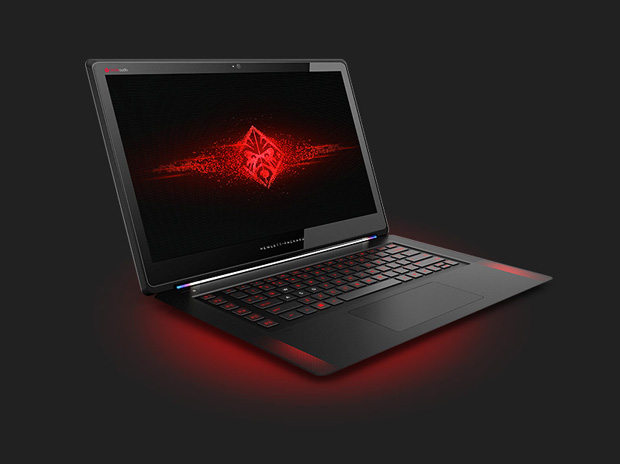PC Gamer's got your back
1976s The Omen
Beautiful touchscreen panel; sexy chassis; portable; good thermals.
2006s The Omen
No hard-drive support; troublesome trackpad; not uber-powerful.
A good sign
The word “omen” generally connotes bad juju for most people. For some longtime PC enthusiasts, however, it evokes fond memories of Voodoo PC’s old beautiful and powerful desktops. While HP isn’t bringing Voodoo PC back from the grave, it hopes to pay homage to the Omen namesake by rebirthing it as a modern gaming notebook.
The Omen isn't the most powerful notebook, but it's one of the most polished.
Right off the bat, you’ll notice that the 15.6-inch HP Omen is one sleek-looking laptop, with its machined-aluminum chassis. The anodized black finish coupled with its thin 0.8 inch body gives the notebook some added sex appeal. It’s also really portable for its class, weighing four pounds, 11.9 ounces.
While we were a little dismayed to hear that it uses a 1080p monitor, something we’ve seen dozens of times over, this isn’t some mediocre display. It uses an IPS panel that features a 72 percent color gamut, which provides beautiful, saturated colors. It also sports a touchscreen, which makes it the first gaming laptop we’ve reviewed that offers one.
We were generally pleased with the keyboard, which offers seven customizable color zones that you can tweak using HP’s Omen Control Panel software. The keys themselves offer a satisfying amount of travel and feel quite tactile, as a result. You also get a column of six macro keys on the left side of the keyboard, which is rare to see in a notebook of this size. We weren’t enamored of the Omen’s trackpad, however. Measuring 5.5 inches across, it’s so wide that we often found our resting fingers interfering with our swiping gestures.
On opposite ends of the trackpad are a pair of LED lights that pulsate with the sound of your audio. It’s a unique touch that gives the notebook added flair. The speakers themselves are quite good and offer decent volume firepower. Despite being licensed by Beats Audio, a company known for its bass-heavy emphasis, the audio here is balanced.
Unlike the sexy chassis, the specs of the laptop aren’t super fancy. It uses a 2.5GHz i7-4710HQ processor for its CPU. For its graphics card, HP went with the GeForce GTX 860M, which is the de facto GPU for thin gaming notebooks. The base model comes with two gigs of GDDR5 VRAM, but ours included four. In regard to system RAM, configs starts out at 8GB, which is fine in most instances, but our maxed-out unit came with 16GB.
CPU performance was pretty average, performing ever so slightly faster than our Alienware 14 zero-point’s 2.4GHz i7-4700MQ processor. In GPU perf, we saw respectable gains between 20 and 60 percent. In short, our graphics tests reminds us that the 860M is a midrange card. It will run the majority of modern games at high settings with smooth framerates, but don’t expect to max out games here.
While the laptop’s performance didn’t blow us away, neither did its fans (pun intended). The Omen isn’t silent, but it’s very reasonable under load. We’d go so far as to say HP found the perfect balance between performance and acoustics. The laptop is able to keep its cool by using dual fans that pull in cool air from the bottom, which it expels through the back. A benefit of this design is that gamers won’t have to worry about warm wrists.
When it came to battery life, the laptop was pretty average. The first time we ran our video-rundown test, the notebook lasted a mediocre 172 minutes. When we turned off all the fancy LED lights, we got an extra half hour. Our biggest concern with the Omen really pertained to storage. While we love the fact that it uses the faster M.2 PCIe standard, we’re a little put off that it doesn’t support traditional hard drives. This means you’re topped off at 512GBs. Luckily, the drive is really fast, and allowed the notebook to boot up in 11 seconds.
The Omen may not be the most powerful notebook out there, but it’s extremely polished and well-designed. Everything from its looks, portability, and thermals are top notch. While our decked-out unit cost $2,100, if you’re looking for a more affordable configuration, we recommend going with the $1,800 model, which includes a 512GB SSD, 8GB of RAM, and an 860M with 2GB of VRAM. It’s still a pretty good Omen.
Our zero point notebook is an Alienware 14 with a 2.4GHz Intel Core i7-4700MQ, 16GB DDR3/1600, a 256GB mSATA SSD, a 750GB 5,400rpm HDD, a GeForce GTX 765M, and Windows 7 Home Premium 64-bit. BioShock Infinite tested at 1920x1080 at Ultra DX11 settings; Metro Last Light tested at 1920x1080 at DX11 medium quality settings with PhysX disabled.


